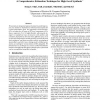Free Online Productivity Tools
i2Speak
i2Symbol
i2OCR
iTex2Img
iWeb2Print
iWeb2Shot
i2Type
iPdf2Split
iPdf2Merge
i2Bopomofo
i2Arabic
i2Style
i2Image
i2PDF
iLatex2Rtf
Sci2ools
ISSS
1995
IEEE
1995
IEEE
A comprehensive estimation technique for high-level synthesis
We present an integrated approach aimed at predicting layout area needed to implement a behavioral description for a given performance goal. Our approach is novel because: (1) it accounts for all types of RT level components (FUs, buses, registers), (2) it is highly flexible, allowing the designer to tradeoff one type of resources with another, and considers dependencies between these different types, (3) it is vertically integrated to include provably accurate physical level estimators, and hence provides realistic accounting of layout effects, and (4) it uses a timing model with finer granularity, accounting for various delays in RTL datapaths. We demonstrate our technique on a variety of HLS benchmarks and showthat efficient and effective design space exploration can be accomplished using this technique.
| Added | 26 Aug 2010 |
| Updated | 26 Aug 2010 |
| Type | Conference |
| Year | 1995 |
| Where | ISSS |
| Authors | Seong Yong Ohm, Fadi J. Kurdahi, Nikil Dutt, Min Xu |
Comments (0)

